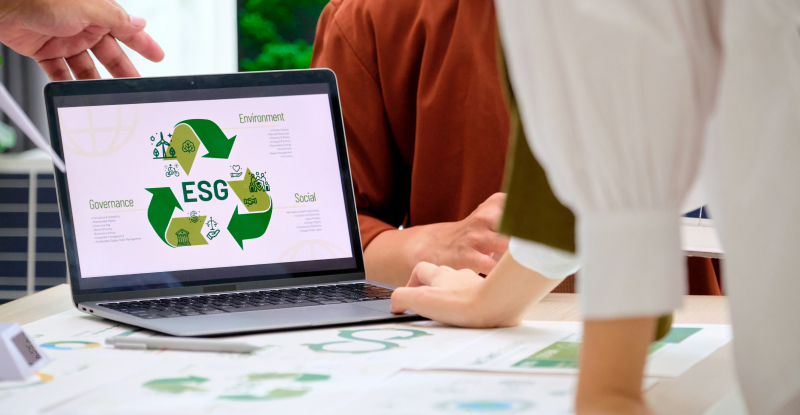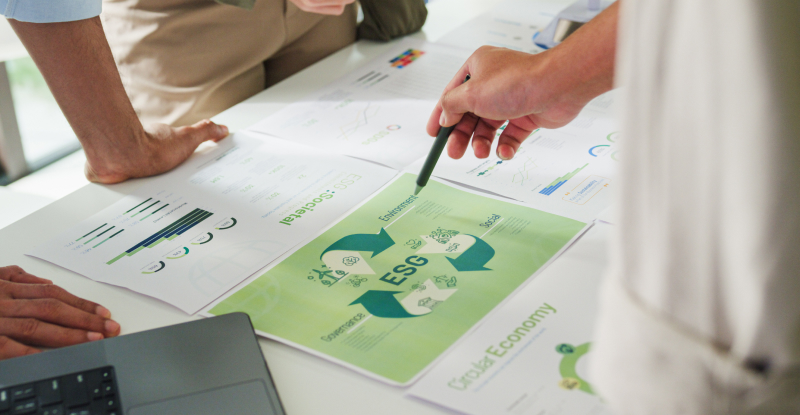
In this podcast episode about Indigenous approaches to ESG investing, Suzanne Trottier, president of FNB Trust, and Mark Podlasly, chief sustainability officer of the First Nations Major Projects Coalition, speak with Lori Mathison, FCPA, FCGA, LLB, president and CEO for CPABC. Part of our Coffee Chats with CPABC podcast series.
As companies move forward with their ESG initiatives, it is essential to prioritize Indigenous involvement, knowledge, leadership, and practices, to ensure these initiatives are successful for all stakeholders involved. Upfront inclusion of Indigenous values and input results in more successful, robust, and resilient initiatives, projects, and investments, as well as contributes to reconciliation and self-determination.
I recently spoke about Indigenous approaches to ESG investing with Suzanne Trottier, the president of the First Nations Bank of Canada's wholly-owned trust company, FNB Trust, and Mark Podlasly, the chief sustainability officer of the First Nations Major Projects Coalition. Their insight follows in our conversation below.
What do Indigenous perspectives and expertise add to the standard definition of ESG and ESG activities?
Suzanne: Indigenous rights and knowledge are integral to any ESG conversation. At First Nations Bank and FMB Trust, we refer to it as IESG, with the ‘I’ meaning Indigenous rights and values. Being the stewards of the land and sustainability go hand in hand.
Mark: From an Indigenous perspective, ESG should include Indigenous values in the valuation of a major project or an investment. At the First Nations Major Projects Coalition, we looked into this and dedicated an entire conference to ESG and ESG frameworks three years ago. We found that of the major ESG frameworks in place at that time, almost none of them had any inclusion of Indigenous values. This has been an issue for Indigenous communities who've been approached by proponents who claim that they have an ESG framework that they're following, but don't include those values. Therefore, a well-drafted framework by a company would include those Indigenous perspectives.
Thinking of major projects and investments that will take place on Indigenous land and in Indigenous communities, what factors in the Indigenous approach to sustainable development should be top of mind?
Mark: For Indigenous communities being asked to host major projects, the number one concern is seeing their values included in the project. It's amazing, even in this day, how many projects will come into a territory already having decided all aspects of the projects without consulting the Indigenous parties. Under the United Nations Declaration of the Rights of Indigenous People, Indigenous People's consent must be sought for projects before they begin.
Indigenous values have to be there. And those values generally fall under the environmental or social categories of ESG. The environmental issues that are important to the First Nation should be addressed, for example, how the project will be carried out and its impact on the environment. Secondly, what are the social ramifications to the community and how is self-determination represented for the community?
What has been FMB Trust's approach in terms of ESG investing and sustainable investing both on Indigenous lands and in Indigenous communities?
Suzanne: At FMB Trust, we act as a trustee or trust administrator on behalf of our Indigenous clients. Typically, if they receive large sums of money, we assist them in developing a framework for managing those monies over the long-term and that usually involves investing. There are some key ways that we approach recognizing Indigenous rights and values in investing and ESG.
The first step is to ensure that the client has considered whether or not direct investing in Indigenous owned and run companies is going to be allowed in their investment strategy. Ensuring that any investment managers that they use are signatories to the principles of responsible investing – that’s table stakes now.
Next, when a client is developing their trust, we ask them to consider allowing direct investments in Indigenous owned and run companies, specifically if it's their own First Nation. That ensures equity participation, and that their values around protecting and respecting the environment and an environmental assessment are included.
Then, we lay out the reporting requirements that they're going to be asking of their investment managers. We ensure that Indigenous impact, values, and companies in which the trust is invested are being reported on and available to the trustees and/or leadership of the nation.
The last step is around shareholder voting and ensuring that the trustees and/or leadership are able to exercise their voice and their priorities as a shareholder in any votes that are tabled related to those companies.
Thinking about the current ESG standards, how inclusive are they of indigenous perspectives and should anything be done to improve them?
Mark: At the First Nations Major Projects Coalition we looked for Indigenous perspectives in standards from the Sustainability Accounting Standards Board, the Task Force on Climate-Related Financial Disclosures, and the Global Reporting Initiative (GRI) and there essentially are none. The most egregious one against Indigenous involvement was in GRI under Section 411, which states that Indigenous interests are only material if a court legal action is initiated, which goes against the whole principle of including Indigenous people.
The International Sustainability Standards Board (ISSB) is looking at including Indigenous people in its frameworks, but it's early days. At this point, the Indigenous involvement in that new standard is still in question. From an Indigenous perspective, there is great interest to ensuring that some sort of Indigenous framework or values are included in ISSB standards because it has direct impact on how projects are planned, financed, constructed, operated, and decommissioned.
What are the business risks of not integrating Indigenous perspectives?
Mark: With projects that do not have strong Indigenous components to them or involve the Indigenous parties, there's a possibility of delays, either through court action, protests, and a community that decides that they do not want the project to proceed. The most upfront risk can be avoided by including Indigenous people from the start, and that means the environmental, cultural, social interests of the nation.
Increasingly, Indigenous people are becoming co-investors in projects. If you have an Indigenous co-investor, you have a co-proponent. If you have a co-proponent, then you have reached consent. And if you've reached consent, you should be able to obtain permitting, approval, capital access, and the support of buyers and consumers.
In respect to ESG reporting, what developments are you seeing?
Suzanne: The recent requirement for climate-related disclosures has come into effect, and FNB is a schedule 1 chartered bank, so we fall under those regulations. That’s an exciting step towards transparency and accountability as it relates to IESG. More and more, we're also seeing companies who are producing sustainability reports, and they're beginning to measure the impact of their operations on the environment, social governments, and Indigenous peoples.
There needs to be more structure around the reporting, and that's where the standard setting process is going to come into play. As well, what still needs to emerge is the assurance framework around the new reporting standards when they come into place. The question is, how can we rely on that data? Right now, there's a lot of greenwashing and a lot of unverifiable information.
How does BC compare nationally and globally in terms of IESG? Who’s leading?
Mark: We've seen a lot of interest from companies trying to include Indigenous values in ESG. But the challenge is that the markets or the ESG investors may not have a framework to recognize that involvement. The ESG frameworks do not have an Indigenous section in them. It's up to the company or the investor to highlight that for investors.
In terms of who's doing it right in BC, the Indigenous-led financial firm Raven Capital out of Victoria is very focused on including Indigenous values upfront in the investments that they approach. Nationally, many pension funds are struggling with this. The challenge national firms have is that it's a big country. Indigenous values can be different in different regions and in different nations, in different provinces, and different treaty areas. It is very local and trying to transfer from a local to a national or increasingly an international audience has been a challenge for the firms.
Suzanne: Having a reconciliation action plan and the training on cultural awareness and the histories of Indigenous peoples is a starting point. In BC, I'm seeing that with a number of organizations. At the national level, the Business Development Bank of Canada (as a disclosure, I sit on that board) started mandatory Indigenous cultural awareness training this past year, both at the board level and with their 2,000 some employees.
The government of BC has also launched an impact or investment fund called InBC Investment Corp. I sit on that board as well. Part of their mandate is to invest in Indigenous companies and entrepreneurs to support the thriving and the development of the Indigenous economy here in BC.
Can ESG be meaningfully used to support reconciliation in BC and Canada?
Mark: As a tool towards reconciliation, the speed of ESG investing has progressed much faster than, at times, the political discussion around reconciliation. ESG is driven by markets. Decisions by companies to make investments in projects will not only help their stakeholders, but also have direct impacts to Indigenous communities. Indigenous communities, and those who wish to participate recognize this. And you're starting to see much more of an alignment between the two and understanding that Indigenous self-determination requires economic resources, and involvement in jobs and economies. Those are direct benefits that come out of a positive reconciliation with Indigenous people.
ESG has a huge role to play. ESG can drive self-determination. Self-determination can drive respect, community involvement, better inter-economic engagement. Going forward, the new ISSB standards and how the Canadian economy decides to approach that is the vital interest to Indigenous people and is in vital interest to our economic prosperity as a nation.
Suzanne: The measuring, reporting, and setting of targets around IESG, and then the assurance framework that's going to be put in place eventually around IESG reporting is going to bring the positive benefits that Mark talked about.
In terms of Indigenous reconciliation and self-determination and participation of Indigenous peoples fully in the economy, it is critical. Partnering with Indigenous Peoples means meaningful participation, influence over the projects, participating on an equity basis, having seats at the board, having structured mentorship opportunities, skills, and trainings, and jobs. And all of that really brings benefits to the project, the company, and especially Indigenous peoples.
If people want to learn more, what resources would you recommend?
Mark: The economic opportunity of climate change and the transition to a low-carbon future for Canada is immense. Canada has the natural resources and the clean energy that we require for not only our economy, but the opportunity to provide those to the world.
Indigenous people have an important part to play in that, given the history of this country and how land and resources are impacted by Indigenous rights. Some estimates are that the Canadian economy will require $2 trillion of investment to make the shift to a low-carbon future. $2 trillion into the Canadian economy benefits all of us. And if Indigenous people are not included in that in a meaningful way, that won't happen.
It’s no longer a question of just Indigenous people. It's a question of our national competitiveness, and our ability to provide the futures and lives that all of us as Canadians have come to rely. I would encourage going to the First Nations Major Projects Coalition's website to learn more about this.
Suzanne: As companies evolve towards developing and implementing a reconciliation action plan, the possibilities are endless.
I often hear at board tables and with companies, "We don't know where to start. We don't know how to approach Indigenous communities if they're looking for a partnership.” When it comes to hiring Indigenous employees they say, "We just can't find them. We can't find the skilled employees."
That's maybe the wrong place to start. It’s starting with cultural awareness training. It's starting with learning about Indigenous peoples, our history, and from there, starting to include Indigenous peoples at every stage of an organization or project and very early on. At FNB, we've got over 120 employees and 70% are Indigenous.
For years we have prioritized the training and hiring of indigenous peoples. On the Trust side, 100% of our employees are Indigenous, and we managed in just under three years to go from zero to over $1 billion in client assets that we administer. And that's only First Nations Trust that we work with. The opportunities are there. The people are there. The professionals are there.
To learn more, I would encourage having a look at our website and CPA Canada’s website. And I would encourage CPAs in general, young and old alike, to look into a career focused on IESG because it's an emerging and very critical area. And CPAs are going to play a critical role in its progress.
Lori Mathison, FCPA, FCGA, LLB is the president and CEO for the Chartered Professional Accountants of British Columbia (CPABC).



